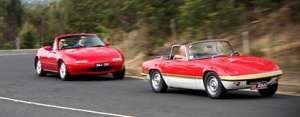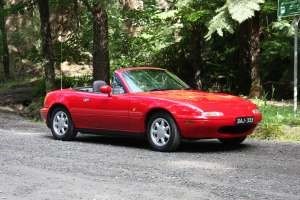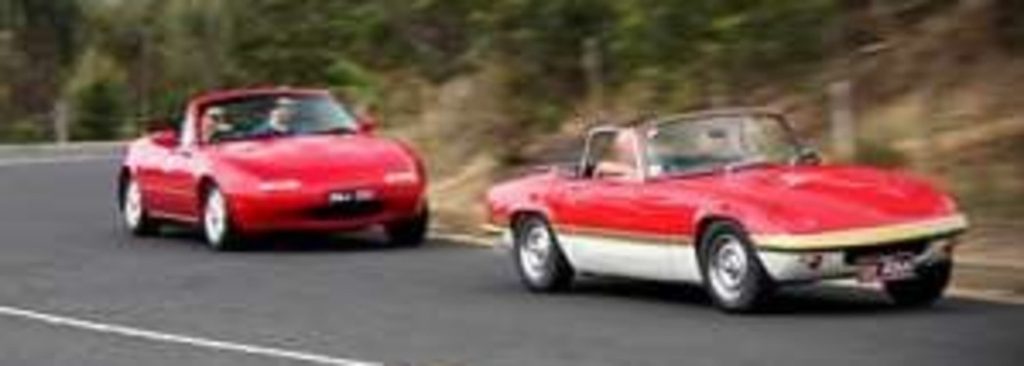Written by Adam Davis:
I found this Lotus Elan v Mazda MX-5 draft in my archives, back from when I was first being published in car magazines. It was first on a website I created with great mate, Brendon. It was also the catalyst for meeting David James, now a DAD director alongside me. What a ride. – AD

After thriving during the sixties, the small roadster market faded away as the late seventies approached, bringing with them stricter safety and emissions regulations in the wake of the oil crisis. This crippled the all important North American market and saw the demise of long time British favourites like the MGB, Triumph Spitfire and the Lotus Elan, widely regarded as the most capable of its genre.
By 1979 fear of a worldwide oil shortage had abated and talk of roadsters being totally outlawed in the US also waned. Enter Bob Hall, an American journalist with a perfectly timed idea. The story goes that, upon meeting with the R and D head of Mazda North America, Mr. Yamamoto, he was asked a last question before parting: “What do you think we should build for this market next?” Bob responded without hesitation: “A lightweight sports car.”
Two years later, Hall had joined the Mazda research team and continued to sow the seed amongst the Japanese engineers. Its chance to sprout came in 1983 when Mazda held an in-house design competition with three entries to be considered; a front-drive hatch similar in concept to the Honda CR-X, a mid engine concept mimicking the Toyota MR-2, and a traditional British influenced small capacity roadster, with rear wheel drive. The roadster won, project P729 was instigated and the precursor to the MX-5 began development in earnest.
The final product, powered by an 86kW (116bhp) 1597cc DOHC four was shown at the Chicago show in February 1989 with several styling cues influenced directly by that sixties English roadster market that it was striving to revive. Seasoned road testers commented on several design features that emulated the Elan- the shape of its cam covers and contours of the bodywork, not to mention the pop up headlights. Even the drive experience nodded to its illustrious forebear, with manual steering a standard, narrow tyres on small wheels, an engine with a thirst for revs (accompanied by a slight rortiness to the exhaust note) and even an engineered-in ‘click-clack’ to the gear shift for added sixties ‘authenticity’.
To Mazda’s credit they never denied seeking inspiration from the past. MX-5 concept engineer Norman Garrett attributed Chapman’s “driver and car as one” approach as a model for his team to pull towards a similar goal. They were known to have two Elans at their disposal during development and came to know them intimately, Garrett stating that the Elan captured their “essence of our philosophy with simple, timeless design.” He went on to say that the MX-5 had more of a personality, though he was perhaps being a touch one-eyed. To redress the balance, we decided to bring an original example of each car together on a lovely Melbourne summer’s day to form an unbiased opinion.
Our featured Elan is a 1968 Series 4 DHC. It is an Australian delivered car that was shipped unpainted to Geoghegan’s, who were the Lotus agents at the time. This car is in true time-warp condition having covered 38,000 miles from new with full ownership history and has never fallen under a restorer’s touch: “It’s just well maintained- but there is always something that needs maintaining!” laughs the owner.
He has made subtle reliability upgrades including the installation of a modern alternator and thermostatically controlled fan that enable the 1558cc twin cam ‘four’ to fire with ease after a flick of the key and not get too hot. Originally rated at 110bhp (82kw), this car has larger, 45mm Weber carburettors rather than the Strombergs most Series 4 Elans utilised.
The car was painted at Geoghegan’s in the Gold Leaf team colours, inspired by the Lotus GP car schemes of the period. Adding a poignant touch are the black Lotus badges, a nod to the immortal Jim Clark who passed away in April 1968.
“The knock-off three-eared wheel spinners are thought to be based off the winning Lotus Indianapolis cars of the time,” the owner explains. This example presents as better than new, unmarked black seats and perfect dash highlighting its microscopic mileage. And the detail…even the more modern tyres it wears are dimensionally correct at 155/80/13.
I ease my 6-foot-2 frame (complete with Christmas kilograms) over the bodywork, into the tiny bucket seat. Shutting the door squeezes my right shoulder, which combines with the tapered foot-well to create a somewhat claustrophobic environment. Grip the evocative tiller, complete with a copy of Chapman’s signature, click the gearshift into first, let out the clutch and…stall it. “The pedal bites solidly at the higher end of its travel,” the owner smiles. Cue quips from the crew about me going for my licence next week! On the second attempt, more throttle and a firmer left foot releases the Elan nicely.
You can really hear those big Webers filling their lungs as you extend the firmly sprung throttle through the length of its travel- but the best thing about a well sorted Elan is its steering. It feels lithe and delicate like the rest of the car (save the carbs and the fabled twin cam exhaust note, all crackly on the overrun) but still tells you what you need to know about the surface beneath. “I get the most pleasure from it out on a curvy road where you just set it up for the corner and sail it through. I don’t push it too hard on the straights except on track…it’s all about nailing the corners,” the owner enthuses as we glide through a sequence of second and third gear bends.
An active member in the Lotus club of Victoria, the owner explains that the only way to truly and safely test its limits is on a circuit, but “then with the short wheelbase, when it finally does let go, you are facing the other way almost instantly. I’ve had that experience at Sandown before…”
Back at road speed, the Elan feels approachable and forgiving in its responses. Turn it in and there is minimal weighing up through the wheel, as expected in a sub-700kg machine. You do, however, sense the nuances of road surface through your fingertips. Let this settle in your mind for a second before the seat of your pants tells you that weight is transferring to the outside front wheel, assisting direction change through supple springing. Turn-in phase complete, you pick your trajectory, adding throttle pressure to balance the forces as weight transfers rearward, digging the back tyres in to slingshot you through the exit. It’s poise is utterly addictive; feeling tip-toe agile yet somehow planted and able to provide astonishing levels of grip for a car made in the sixties, running miniscule tyres, and “all this with Triumph Herald steering!”
The Elan is synergy defined- a whole being greater than the sum of its parts (including Lotus Cortina switchgear and Alfa Giulietta stop and indicator lenses), and oozes personality out of every pore.
The MX-5 belongs to a former club president. His example is one of the 45,000 made in 1989 and sports the increasingly hard to find hardtop. The car is unmodified save for some adjustable Koni shocks, set to full soft for road use.
Climbing into its cockpit is less of a moment than in the Elan, for is it a much simpler experience. Again height seems to be my issue for on the standard seats my head can easily clatter the roof, my line of vision filled with the upper edges of the windscreen. The owner informs that a “friend who is 6-foot-7 drove one for years by removing most of the padding underneath,” but I stop short of asking if I can do the same.
Simplicity of design oozes from the MX-5, with subtleties like the rear tail-lights and diminutive chrome door handles adding a touch of class. “It’s such a well thought out car, everything about it was designed to be user friendly,” the owner beams. “About the only thing I would change is the position of the electric window switches which are on the rear of the centre console. You always find yourself fumbling for them while on the move.”
From the moment we pull out in the MX-5, the differences to the Elan are perceptible. The main controls meet their design brief of being a car fit for a world market, being tactile yet easy to use. Its steering (also unassisted through a gorgeous three-spoke Momo) is instantly heavier although that is to be expected with another 250kg or so riding on fatter, 185/60 tyres with 14-inch ‘Minilite’ style wheels.
You do miss out on the fuel system symphony through temperamental carbs but the exhaust note, an area the Japanese carefully considered in the development phase, makes up for it. Appropriately effervescent, it is further enhanced sans hardtop, or, in other words, ‘as it should be’.
Engine-wise the MX-5 spins eagerly and responsively to its 7200rpm redline, and is well matched to a wonderfully slick, short-throw five-speed gearbox. The motor loves revs, as its 135Nm torque peak at 5,500rpm indicates, but there is never really a step up in its delivery, no top end sparkle to really make the Mazda dance. This contributes to its friendly nature, but is not ultimately exciting when compared to the Ford based twin cam in the Elan, which feels alert and torquey at lower revs before hardening its note as the redline approaches. Again, the weight advantage contributes significantly to the Elan’s superior acceleration, its snorting engine note also worth at least 20 imaginary horsepower.
Back in the MX-5, everything feels a dimension bigger; neither owner could believe the actual size difference when the cars were side by side.
As a consequence the key human interfaces feel weightier and more solid in the Mazda (except, interestingly the clutch pedal) and this is reflected in the handling balance. There is less a sense of delicate poise, and though agile when compared to most, it falls short in such exalted company.
Mixed curves reveal more of its repertoire, its aluminium ‘Power Plant Frame’ (a structure bolted between gearbox and diff) contributing to the Mazda feeling more ‘all-of-a-piece’ than the Elan, but the disadvantage here is that subtle transitions in weight are not as well defined. More reassuring is the meatiness evident in the MX-5’s steering, allowing you to more completely feel the build up of cornering forces; a bonus in communicating on-track grip limits. “They really come alive on the track, everything just blends together so well,” adds the owner. Even under brakes, the car feels planted with a nicely firm pedal building confidence in its stopping abilities. At corner exit, even under heavy throttle, oversteer just never seems to enter the equation. This would make an ideal track car for someone new to rear-wheel drive.
Both of these cars are icons of their time and feel almost magical compared to frumpy modern machines with their agility and user-friendly, unfiltered controls. But it is difficult to truly judge them based on ‘personality’ as it is a matter of personal taste. Are Lotus electronics endearing or frustrating? That depends on the person.
Ignoring their relative values, if you wanted to choose one for weekends only, and are handy with the tools, it would be the Elan. Its engine is more characterful, and developing your skills over time to match its handling characteristics would provide a source of great pleasure. It also has the cachet of a Lotus badge which is difficult to ignore.
The MX-5 is more instantly friendly, a car you could use every day if you wanted to. Its cornering traits are more predictable, its limits less daunting to challenge. And it’s utterly reliable while providing most of the thrills found so abundantly in the Lotus. When you do factor in price the Japanese roadster becomes still harder to ignore, but I just have to. Though my mind prefers the Mazda, my heart loves the Lotus.


